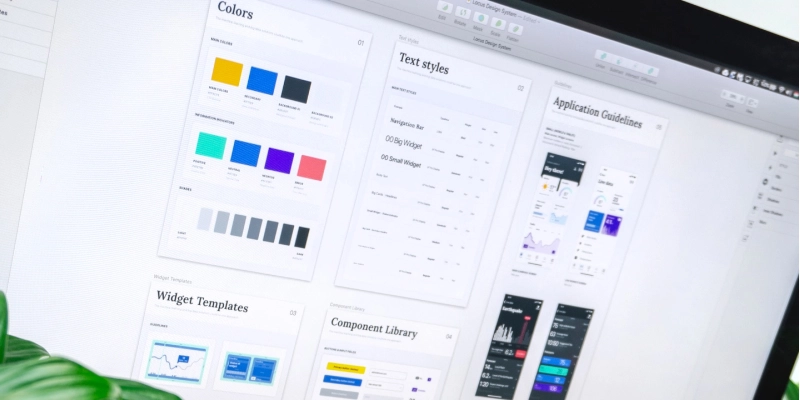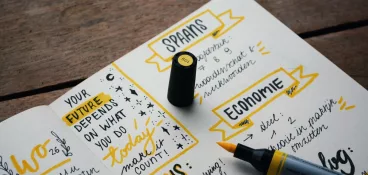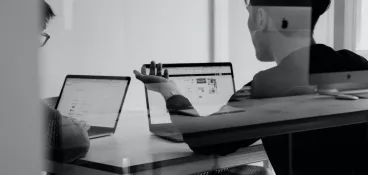In the world of graphic design, success often hinges on the quality of the design brief itself. Whether you’re working with an in-house design team or external designers, a well-crafted design brief is the foundation of a successful project, aiding the design process.
The design brief acts as the roadmap that guides the design process, encapsulating the scope of the project to make sure that all contributors and collaborators are on the same page with the project’s goals and objectives.
Here at Filestage, we understand that it’s easy to want to rush through the creative brief. But, with the help of this comprehensive guide, we can help to understand the intricacies of a perfect design brief that leads to five-star quality design projects.
It’ll equip you with the knowledge to create a design brief that inspires innovation, ensures alignment, and guarantees exceptional results.
So join us as we delve into the heart of an effective design brief, how to build the perfect design brief, and explore the nuances that set in-house and external briefs apart.
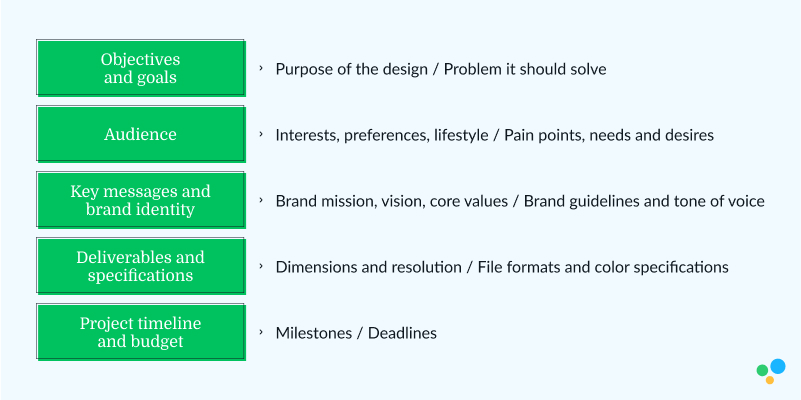
1. Define your objectives and goals
The first step to write a design brief that delivers outstanding results is to clearly define your objectives and goals. Without a clear sense of what you aim to achieve, your design project is likely to veer off course. This step is crucial for both an in-house and external design brief.
- In-house briefs: When working with an in-house design team, it’s often easier to align on objectives and goals because the team is already familiar with the organization’s mission and vision. But it’s essential to provide a specific project context and clear goals within the broader company objectives.
- External briefs: When collaborating with external designers, you need to provide detailed information about your organization, its mission, and the specific goals you want to achieve with the project. The external designers may not have the same level of familiarity with your brand, so clarity is key!
Start by asking yourself and your team a series of questions:
- What is the purpose of this design project?
- What do we want to communicate or achieve through this design?
- Who is our target audience and what are their preferences and expectations?
- Are there any specific problems we are trying to solve through this design?
- What is the desired budget and timeline for the project?
By answering these questions, you can establish a solid foundation for your design brief.
Ensure that your objectives and goals are specific, measurable, relevant, and have an achievable timeframe to make it easier to evaluate the project’s success later.
2. Research and understand your audience
Design is not just about aesthetics. It’s about communication, too.
To write a design brief that appeals to and understands your target audience, you must thoroughly research them. This step is crucial for both an in-house and external design brief.
- In-house: It’s essential to keep audience preferences and behaviors up to date. Regularly revisiting audience research is crucial for this step.
- External: Provide comprehensive information about your target audience, including demographics, psychographics, and behavior. External designers may not be familiar with your audience, so this will help them tailor their work to effectively connect with your audience.
Consider including the following in your audience research:
- Age, gender, location, and other demographics
- Interests, preferences, and lifestyle
- Pain points, needs, and desires
- How they consume information (online, print, social media, etc.)
Study your competitors and the design trends in your industry. Knowing what’s already out there can guide your designers to create something fresh and innovative while keeping you one step ahead!
3. Establish key messages and brand identity
In this step, you’ll need to define the key messages you want to convey through your design and reinforce your brand identity. This is important for both an in-house and external design brief.
- In house: The main advantage for working with an in-house design team is that they’re already experts on your brand’s mission, vision, and core values. That being said, it’s still crucial to communicate any specific changes or updates in brand identity.
- External: External designers need a comprehensive understanding of your brand, its mission, and its core values. Provide them with any brand guidelines, such as color schemes, fonts, and imagery. Clarify the tone of voice your brand should convey to make things as clear as possible for external designers.
Key elements to include in your design brief:
- Your brand’s mission, vision, and core values
- Any brand guidelines, such as color schemes, fonts, and imagery
- Your brand’s tone of voice
- Any existing marketing materials or campaigns that your design should align with
This information will help your designers ensure that the design is consistent with your brand’s identity and effectively communicates your intended messages.
4. Set clear deliverables and specifications
Clarity is crucial in a design brief, regardless of whether you’re working with an in-house or external design team. Your designers need to know exactly what you expect from them to receive top-notch work in return.
- In-house: In-house designers may have a better understanding of the technical specifications and preferences of the organization. But it’s still essential to specify the type of design, dimensions, file formats, and any other technical details, leaving no stone unturned.
- External: When working with external designers, provide precise guidelines for deliverables and specifications. This may include details like the type of design (e.g., logo, website, brochure, social media graphics), dimensions and resolution, preferred file formats, and color specifications (PMS, CMYK, RGB).
By providing precise guidelines, you minimize the potential for misunderstandings and revisions later in the project. Be sure to indicate any preferred design style or inspiration sources to further guide the designers.
5. Define the project timeline and budget
Every design project needs a timeline and a budget. Without these constraints, projects can easily spiral out of control.
- In-house: In-house design projects may have more flexibility in terms of timelines and budgets. But it’s still important to establish realistic budgets and timelines to manage expectations and resources effectively, without putting extra stress on the design team.
- External: When working with external designers, specify the expected timeline for different project phases, from initial concepts to final delivery.
Include milestones and deadlines to keep the project on track, ensuring your timeline is clear and thorough.
Budget considerations are critical. Be transparent about the financial constraints and expectations.
As with everything, we don’t know if it’s going to go to plan. There are always hurdles and last-minute challenges, which can lead to changes in your timeframe.
It’s advisable to have a contingency for unforeseen expenses or changes, regardless of whether the design team is in-house or external.
In-house or external? Find which one is more suited to you
In-house and external design briefs have some key differences due to the nature of the teams involved. Here’s how to differentiate between in-house and external design teams to help when creating your design brief:
In-house design brief
Here are the benefits of creating a design brief for your in-house team:
- Familiarity: In-house design teams are intimately familiar with the organization’s brand, culture, and other teams. This can streamline the briefing process as most briefs will be easily digestible for designers.
- Continuous collaboration: In-house designers can engage in ongoing collaboration with other departments, ensuring a deep understanding of the company’s goals and creating an efficient workflow.
- Easy access: Communication is often more straightforward when the design team is within the same organization. By default, communication may be easier between teams that are more familiar with each other.
- Resource allocation: In-house design teams are typically considered a fixed resource, allowing for more control over project timelines and budget constraints.
External design brief
Here are the benefits of creating a design brief for external partners:
- A fresh perspective: External designers bring a fresh perspective and creativity to the project. They’ll have a wealth of experience under their belt which allows for an open mind and informed design choices.
- Expertise: External designers are specialists in design and can provide unique insights and skills. They’ve presumably had a wide range of experience in different industries and projects and can easily draw from this when completing a brief.
- Objectivity: Because external designers are somewhat unfamiliar with the brand’s identity and company as a whole, they can offer an unbiased perspective when working on design projects.
- Resource scalability: External designers can be scaled up or down as per project requirements, offering flexibility. It’s also beneficial for companies to have the ability to choose a designer that’s more suited to their specific project.
Top tip: Use a design brief template when creating a design brief. Lucky for you, we’ve designed the ultimate creative brief template and how to use it. Take a look!
How to make sure content hits the design brief
Technology plays a pivotal role in streamlining the design process and improving efficiency. And when it comes to sharing your designs for feedback and sign-off, Filestage’s design approval software has you covered.
In just a few minutes, you can set up a project overview of your approval workflow, invite reviewers, and start sharing your designs and adding annotations. Then, you can attach the full design brief or include a summary in the comments to remind people of the goals of your project.
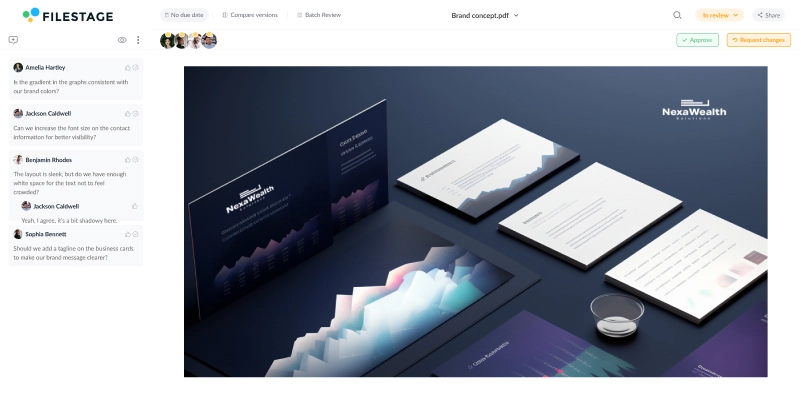
Here are some other ways Filestage streamlines your design review process:
- Comments – point and click to create markers and add comments on top of your content
- Timecodes – create automated timecodes when you add comments to videos and audio files
- Annotations – bring comments to life with lines, arrows, boxes, and freehand markups
- Attachments – attach references and other assets to your comments to keep everything centralized
- Review steps – keep comments organized with review steps for different types of stakeholders, like Marketing or Client
- Due dates – set due dates and send automated reminders to make sure feedback always arrives on time
- To-do lists – turn comments into actionable feedback by using them as to-do lists
- Compare versions – see two versions side by side to check what’s changed, including all the comments
- Status indicators – see which files are approved or ready to be worked on at a glance
- Integrations – connect Filestage with your project management and messenger apps to keep your whole team up to date
Final thoughts
A well-crafted design brief is the linchpin of a successful design project as it streamlines the design process. By following the five-step design brief outlined in this article, you can ensure that your designers, whether in-house or external, have a clear and comprehensive guide to follow.
Despite the difference between in-house and external design teams, the principles of a good design brief remain the same: clear objectives, a deep understanding of the audience, a strong brand identity, precise deliverables, and a well-defined timeline and budget.
The choice between in-house and external design teams ultimately depends on your organization’s resources, goals, and the specific project at hand. Both options have their advantages, and your decision should be based on your project’s unique requirements.
Brief building software can significantly enhance the efficiency and effectiveness of the design process. It streamlines the creation of design briefs, making it easier to collaborate, standardize, and track changes.
When choosing a brief building software, carefully consider your organization’s needs and the specific features that will best support your design projects.
By adopting these best practices and utilizing modern tools, you can consistently achieve 5-star results in your design projects.

